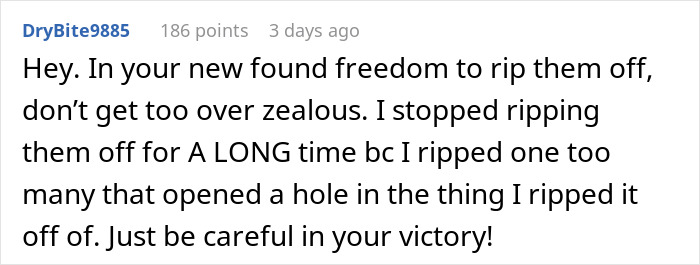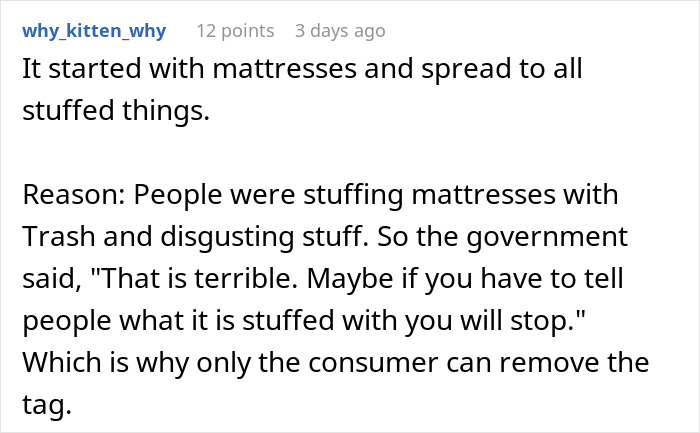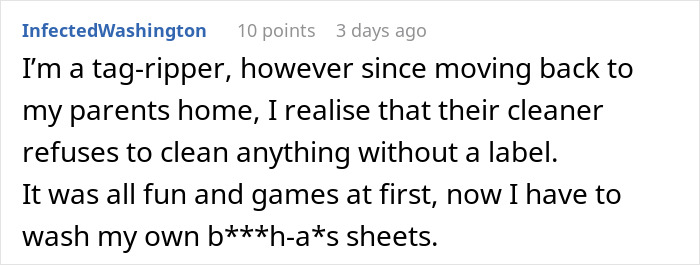
“If You Can’t Beat Them, Join ‘Em”: Guy Uses Petty Revenge To Win Tag War Against Wife
Ah, the mystery of the mattress and pillow tags. Why are they there? Why can’t we remove them? Why do the manufacturers threaten us with breaking the law if we do remove them? It’s a bit different from the tags we see on clothes – the only crime of those is that they often make us itchy.
One man went to Reddit to share his gripe with dealing with the annoying tags on house items. He told the r/PettyRevenge community how his wife asked him not to remove them for some reason. The problem – he’s a serial tag-ripper. He didn’t see the point in leaving them on, so he came up with a petty revenge strategy. Read on to find out what it was.
A new house item, like a decorative pillow, is often ruined by a non-aesthetically-looking white tag
Image credits: h2101111 (not the actual photo)
One man got into a minor fight with his wife over whether or not they could remove the tags
Image credits: Timur Weber (not the actual photo)
Image credits: florizonaman
If you remove those pesky tags, you won’t be breaking any laws
Some commenters already touched upon this, but the reality is that there’s no penalty for removing a tag from a mattress or a pillow. The label clearly states “Not to be removed except by the consumer.” So if you’re ripping the tag off after you bought the item, there’s no crime.
But why is this such an issue in the first place? How did it come to be that people believe they should not remove these tags? This little piece of white paper attached to a house item is what we call a Law Label. The “Do Not Remove” clause applies only to manufacturers and retailers.
Justin Paddock, Chief of the Bureau of Electronic and Appliance Repair, Home Furnishings and Thermal Insulation (BEARHFTI) told the California Department of Consumer Affairs why the labels are there.
“These labels ensure consumers know if the products they are purchasing are new or used, contain added chemicals, may pose a risk to family members with allergies, and that products meet basic flammability requirements. In short, these labels protect the health and welfare of households.”
Image credits: Kam Idris (not the actual photo)
Manufacturers used to stuff bedding and other items with all sorts of wild things
President of Legal Label Maggie Terry recounted the history of mattress and pillow labeling to WGBH. She refers to the turn of the 20th century as the “wild wild west” phase for manufacturers. Apparently, they would stuff bedding with all kinds of things.
“Newspapers, dirty rags, sweepings off the floor, part of their lunches, droppings, anything,” the president of Legal Label said. In some cases, the stuffing also included horsehair, chopped-up old hospital or hotel mattress innards, and corn husks.
This caused bacteria and vermin to flourish inside the stuffing. As time went by, it became a serious public health issue. Thus a need for some regulation arose. The laws concern items that have material that a consumer cannot touch and see. Think the already mentioned mattresses and pillows, but things such as stuffed animals and comforters qualify too.
The new laws required manufacturers to list things that were inside the items. For the customer to know this information, the manufacturer and the retailer therefore cannot remove the Law Label. So that means we can be sure what we’re getting and that the labels don’t lie, right?
Well, not quite. The manager of the bedding, upholstered furniture and quilted clothing program for the Department of Agriculture in Utah Michelle Jack also told WGBH that violations still happen. She recounts how her lab finds some labels to be misleading.
There have been instances where manufacturers label their mattresses as hypoallergenic, but they are in fact stuffed with unclean duck feathers. Other times, they’ve found supposed down jackets filled with poly-fibers. Maybe there’s no more horsehair, but there’s plenty of misleading labeling still happening in the manufacturing process.
Image credits: Marlon Corona (not the actual photo)
So where does the confusion about ripping them off come from?
The myth that consumers cannot tear the Law Labels off comes mostly from word of mouth and popular culture. Mattress company Serta has even put out a commercial where sheep get to do jail time for tearing the labels off mattresses. The company that makes mattresses is no doubt aware of the law, yet it’s a nice play on public consciousness.
There are some similar examples in animated shows. There’s a scene in the season four episode of SpongeBob SquarePants that reiterates this myth. “Squidward, I accidentally removed the ‘Do Not Remove by Penalty of Law’ tag on my mattress! Hide me! Hide me!” the character shouts in fear.
The first episode of Garfield And Friends features a similar scene. The second segment of the show Wanted: Wade is about how the character tears the label off a sofa and is then scared he will go to jail. The rest of the segment debunks the myth, as Wade is not punished and the friends reassure him that no one will arrest him.
Image credits: Stephanie Harvey (not the actual photo)
Commenters shared their own experiences with dealing with the annoying tags
Poll Question
Thanks! Check out the results:
A) the tags have the cleaning instructions on them, and b) soft/upholstered furnishings without the tags are often not allowed to be sold or donated. It's a fire-safety thing.C) Cleaners and drycleaners will often refuse to clean tagless items, as the material and cleaning instructions are missing.
I just love reading about married couples who are actually enemies...not!
Clip, don’t rip and leave the cleaning instructions on. Also, don’t be a d**k.
A) the tags have the cleaning instructions on them, and b) soft/upholstered furnishings without the tags are often not allowed to be sold or donated. It's a fire-safety thing.C) Cleaners and drycleaners will often refuse to clean tagless items, as the material and cleaning instructions are missing.
I just love reading about married couples who are actually enemies...not!
Clip, don’t rip and leave the cleaning instructions on. Also, don’t be a d**k.

 Dark Mode
Dark Mode 

 No fees, cancel anytime
No fees, cancel anytime 




































































21
11